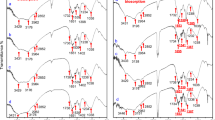Abstract
Samples of mixed liquor from a laboratory-scale activated sludge simulation, operated at a range of sludge ages from 3 to 12 days, were treated with formaldehyde in order to obtain a metabolically inactive biomass. The metal removal behavior of this biomass was compared with that of untreated biomass. Only Cu and Ni were found to exhibit a high degree of removal in the presence of active biomass. Manganese, Cd, Co, and Tl demonstrated removals little affected by the activity of the biomass, and at longer sludge ages more metal was taken up by formaldehyde-treated than by untreated cells.
Dispersed mixed liquor in the form of a bulking sludge was found to have a greater affinity for most metals than a well-settled, compact mixed liquor. Consequently, it is proposed that the important factors in metal removal by the mixed liquor solids were related to their behavior as particulates, the physical characteristics of the particle being more important than their viability.
Similar content being viewed by others

References
Barrow NJ (1978) The description of phosphate adsorption curves. J Soil Sci 29:447
Bitton G, Freihofer U (1978) Influence of extracellular polysaccharides on the toxicity of copper and cadmium towardsKlebsiella aerogenes. Microb Ecol 4:119
Brown MJ, Lester JN (1982) Role of bacterial extracellular polymers in metal uptake in pure bacterial culture and activated sludge. II. Effects of mean cell residence time. Water Res 16:1549
Bucheder F, Broda E (1974) Energy dependent zinc-transport byEscherichia coli. Eur J Biochem 45:555
Burton K (1955) A study of the conditions and mechanism of the diphenylamine reaction for the colorimetric determination of DNA. Biochem J 62:315
Cheng MH, Patterson JW, Minear PA (1975) Heavy metals uptake by activated sludge. J Water Pollut Control Fed 47:362
Friedman BA, Dugan PR (1968) Concentration and accumulation of metallic ions by the bacteriumZoogloea. Develop Ind Microbiol 9:381
Gadd GM, Mowill JL (1983) The relationship between cadmium uptake, potassium release and viability inSaccharomyces cerevisiae. Microbiol Lett 16:45
Griffin RF, Au AK (1977) Lead adsorption by montmorillonite using a competitive Langmuir equation. Soil Sci Soc Am J 41:880
Kelly DP, Norris PR, Brierley CL (1979) Microbiological methods for the extraction and recovery of metals. In Microbial Technology: Current state, future prospects. Soc. for Gen. Microbiol. Symp. No. 29, Ed Bull A. T., D. C. Ellwood and C. Ratledge, University Press: 263 Cambridge
Kushner DJ (1971) Influence of solutes and ions on micro-organisms. In Hugo WB (ed) Inhibition and destruction of the microbial cell. p. 259 Academic Press: London
Lawson PL, Sterritt RM, Lester JN (1984) Factors affecting the removal of metals during activated sludge wastewater treatment I. The role of soluble ligands. Arch Environ Contam Toxicol 13:383–390
Lester JN, Perry R, Dadd AH. (1979) The influence of heavy metals on a mixed bacterial population of sewage origin in the chemostat. Water Res 13:1055
Lowry OH, Rosebrough NJ, Lewisfarr A, Randall RJ (265) Protein measurement with the phenol reagent. J Biol Chem 193:265
Macaskie LE, Dean ACR (1982) Cadmium accumulation by microorganisms. Environ Technol Lett 3:49
McDermott GN, Post MA, Jackson BN, Ettinger MB (1965) Nickel in relation to the activated sludge and anaerobic digestion processes. J Water Pollut Control Fed 37:163
Mitra RS, Grey RH, Chin B, Bernstein IA (1975) Molecular mechanisms of accomodation inEscherichia coli to toxic levels of cadmium. J Bact 121:1180
Mustermann JL, Morand J (1977) Formaldehyde as a preservative of activated sludge. J Water Pollut Control Fed 49:45
Nelson DL, Kennedy EP (1971) Magnesium transport inEscherichia coli inhibition by cobaltous ion. J Biol Chem 246:3042
Nelson PO, Chung AK, Hudson MC (1981) Factors affecting the fate of heavy metals in the activated sludge process. J Water Pollut Control Fed 53:1323
Norris PR, Kelly DP (1977) Accumulation of cadmium and cobalt bySaccharomyces cerevisiae. J Gen Microbiol 99:317
Paton WH, Budd K (1972) Energy dependent zinc-transport byEscherichia coli. Eur J Biochem 45:555
Perrin DD, Dempsey B (1974) Metal ion buffers. Chap. 7. Chapman and Hall: London
Pickett AW, Dean ACR (1976) Cadmium and zinc sensitivity and tolerance inKlebsiella (Aerobacter) aerogenes. Microbios 15:79
Pike EB, Carrington EG (1972) Recent developments in the study of bacteria from activated sludge. Water Pollut Control 71:583
Silver S, Budd K, Leahy KM, Shaw WV, Hammond D, Norvick RP, Willsky GR, Malamy MH, Rosenberg H (1981) Inducible plasmid determined resistance to arsenate, arsenite and antimony (III) inEscherichia coli andStaphylococcus aureus. J Bacteriol 146:983
Silver S, Johnseine P, King K (1970) Manganese active transport inEscherichia coli. J Bacteriol 104:1299
Sposito G (1979) Derivation of the Langmuir equation for ion exchange reactions in soils. Soil Sci Soc Am J 43:197
Sterritt RM, Brown MJ, Lester JN (1981) Metal removal by adsorption and precipitation in the activated sludge process. Environ Pollut (Series A) 24:313
Stoveland S, Lester JN (1980) A study of the factors which influence metal removal in the activated sludge process. Sci Total Environ 16:37
Tynecka Z, Zajac J, Gos Z (1981) Energy dependent efflux of cadmium coded by a plasmid resistance determinant inStaphylococcus aureus. J Bacteriol 147:313
Veith JA, Sposito G (1977) On the use of the Langmuir equation in the interpretation of “adsorption” phenomena. Soil Sci Soc Am J 41:697
Webb M (1970) Interrelationships between the utilization of magnesium and the uptake of other bivalent cations by bacteria. Biochim Biophys Acta 222:428
Weiss AA, Silver S, Kinscherf TG (1978) Cation transport alteration associated with plasmid-determined resistance to cadmium inStaphylococcus aureus. Antimicrob Agents Chemother 14:856
Author information
Authors and Affiliations
Rights and permissions
About this article
Cite this article
Lawson, P.S., Sterritt, R.M. & Lester, J.N. Factors affecting the removal of metals during activated sludge wastewater treatment II. The role of mixed liquor biomass. Arch. Environ. Contam. Toxicol. 13, 391–402 (1984). https://doi.org/10.1007/BF01056254
Received:
Revised:
Issue Date:
DOI: https://doi.org/10.1007/BF01056254



